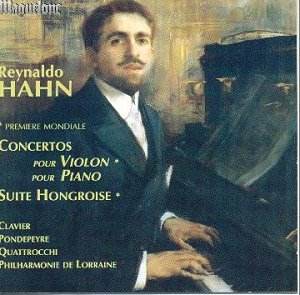How agreeable it is to listen to three sunny melodic
works, so full of warmth and nostalgia with the minimum of angst. It
really is amazing how these works have escaped the recording studios
for so long. Although, in a way, perhaps, it isnít, for it has only
been in the last few years that the musical establishment has turned
away from atonality and admitted a (sneaking?) liking for such unashamedly
Romantic, even sentimental, works like these gems.
Hahnís music, redolent of the ĎBelle Epocheí of the
1890s, and the period leading up to World War I, is very approachable,
well crafted and often surprisingly original. So far it has only been
his songs, and little else, that has been represented in the catalogues
so this disc is doubly welcome.
The Piano Concertoís opening movement, marked
Improvisation: modéré, begins in an almost devotional
manner before broadening out to embrace material that has a rather cosy
French provincial rustic flavour. The second subject is reminiscent
of Schumann. Succeeding moods contrast the intimate and dreamy with
a rumbustious out-of-doors freshness. The brief central Dance: vif,
is full of wit and sparkle and reminds one of Saint-Saëns in playful
mood and suggests pre-echoes of Poulencís insouciance. The substantial
final movement is cast in the form of a triptych: first a lovely, sighing
Schumann-like Rêverie that truly haunts; the tempo accelerates
into the unruly self-mocking Toccata and the whole is rounded
off with a return, after a cadenza, to a dignified close with an allusion
to the opening material. A delightful work.
Hahnís Piano Concerto (first performed in 1930) is
available on a historic recording conducted by the composer with soloist,
Magda Tagliaferro (Pearl GEM0157) and there is a modern alternative
(Hyperion CDA66897) with Stephen Coombes and the BBC Scottish Symphony
Orchestra conducted by Jean-Yves Ossonce. Reviewing the latter performance,
earlier, I was impressed with Coombesís sparkling wit and virtuosity.
Pondepeyreís rather careful approach cannot quite match Coombesís lightness
of touch.
Hahnís Violin Concerto and Suite Hongroise receive
their premier recording on this disc.
Denis Clavier is a more assured soloist in the lovely
Violin Concerto; his sweet poetic phrasing and technical control
a delight to the ear. The work was premiered in 1928. The opening movement
marked Décidé, reminds one of the opulence of Korngold.
It is strongly rhythmic with determined orchestral tuttis that are slightly
military and even jazzy in character but the music is predominantly
beautifully lyrical, joyous and sunny with the melodic sweetness of
Massenet. Massenet also informs the central movement, Chant díamour,
subtitled ĎSouvenir de Tunisí and, indeed, the heat and languor
of North Africa is nicely brought to mind. This movement is a gorgeous,
fragrant, sensual confection; as one of my colleague reviewers has so
aptly written, "(it) hovers between dance and delirium". The
finale, Lent Ė Vif et léger, opens quietly so as
not to destroy the mood of the slow movement, but soon the pace accelerates
and we are whirled away in a merry dance. This performance of the Violin
Concerto was recorded live.
Amazingly, the Hungarian Suite for Violin, Piano,
Percussion and String Orchestra appears never to have been previously
performed. It is difficult to date; the score deposited at the SACEM
(Society of Authors, Composers and Music Publishers) was simply marked
"19th November 1948". It is a charming, melodic
work beginning with a zestful rhythmic movement, Parade, that
sounds like a robust mix of Slav and Scottish dance figures. The second
movement, Three Images de la Reine de Hongrie, is cast
in three sections, two slow enclosing a more agitated passage. It begins
in deep romantic yearning (with yet another lovely Hahn melody) and
ends plaintively. The last movement, Chants et Danses brings
this delightful work to a lively conclusion.
A truly enchanting album calculated to chase away the
winter blues. It is incredible to believe that these are premier recordings
of Hahnís Violin Concerto and the Suite Hongroise, both are so effulgently
melodic.
Ian Lace


